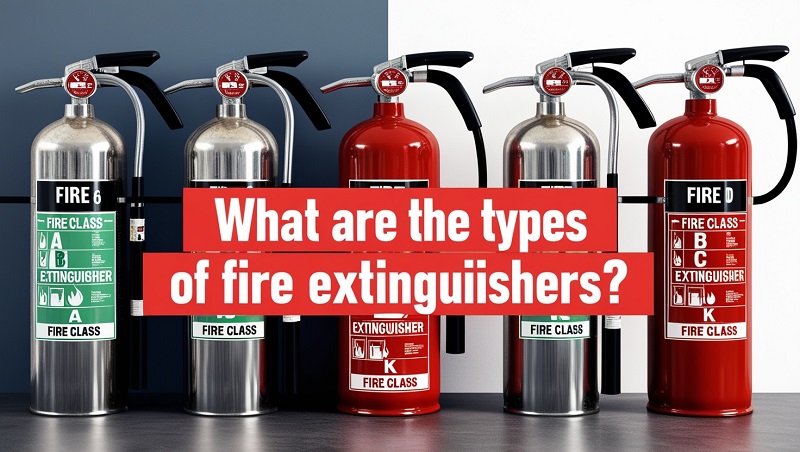Fire extinguishers are essential tools for controlling and extinguishing small fires before they escalate into larger emergencies. However, not all fires are the same, and using the wrong type of extinguisher can be ineffective or even dangerous. This guide explores the different types of fire extinguishers, their uses, and how to choose the right one for different fire situations.
Why Are There Different Types of Fire Extinguishers?
Fires are classified based on the materials that are burning, such as wood, liquids, gases, or electrical equipment. Each type of fire requires a specific extinguishing agent to safely and effectively put it out. Fire extinguishers are categorized to match these fire classes, ensuring safety and effectiveness.
Fire Classes and Their Corresponding Extinguishers
Before diving into the types of extinguishers, it’s important to understand the fire classifications:
- Class A Fires: Involve ordinary combustibles like wood, paper, cloth, and plastics.
- Class B Fires: Involve flammable liquids such as gasoline, oil, and alcohol.
- Class C Fires: Involve electrical equipment like wiring, appliances, and circuit breakers.
- Class D Fires: Involve combustible metals such as magnesium, titanium, and sodium.
- Class K Fires: Involve cooking oils and fats, commonly found in commercial kitchens.

Types of Fire Extinguishers
1. Water Fire Extinguishers
- Best For: Class A fires (ordinary combustibles).
- How It Works: Sprays water to cool the burning material, removing heat and stopping the fire.
- Important Note: Do not use on Class B or Class C fires. Water can spread flammable liquids and conduct electricity.
2. Foam Fire Extinguishers
- Best For: Class A and Class B fires (combustibles and flammable liquids).
- How It Works: Forms a foam blanket over the fire, cutting off oxygen and cooling the material.
- Common Uses: Gas stations, warehouses, and homes with fireplaces or gas stoves.
- Limitations: Not effective on Class C fires involving electrical equipment.
3. Dry Powder Fire Extinguishers
- Best For: Class A, B, C, and some Class D fires (combustibles, flammable liquids, and electrical equipment).
- How It Works: Releases a fine powder that smothers the fire by blocking oxygen and disrupting chemical reactions.
- Common Uses: Suitable for a wide range of environments, including homes, offices, and industrial sites.
- Limitations: Not ideal for enclosed spaces as the powder can reduce visibility and cause breathing difficulties.
4. Carbon Dioxide (CO₂) Fire Extinguishers
- Best For: Class B and Class C fires (flammable liquids and electrical equipment).
- How It Works: Releases carbon dioxide gas, which displaces oxygen and cools the fire.
- Common Uses: Offices, data centers, and places with electrical equipment.
- Limitations: Not effective on Class A fires and can cause frostbite if the nozzle is touched during use.
5. Wet Chemical Fire Extinguishers
- Best For: Class K fires (cooking oils and fats).
- How It Works: Sprays a wet chemical solution that cools the fire and creates a soapy layer, preventing re-ignition.
- Common Uses: Commercial kitchens, restaurants, and cafeterias.
- Limitations: Not suitable for other types of fires.
6. Specialized Extinguishers for Class D Fires
- Best For: Class D fires (combustible metals like magnesium, titanium, or sodium).
- How It Works: Dispenses a dry powder specifically designed to absorb heat and smother metal fires.
- Common Uses: Laboratories, industrial facilities, and factories working with metals.
- Limitations: Ineffective on Class A, B, or C fires.
How to Choose the Right Fire Extinguisher
Identify Fire Hazards:
- Assess your environment to determine the most likely types of fires.
- For example, homes might require extinguishers for Class A (ordinary combustibles) and Class B (flammable liquids), while offices might focus on Class C (electrical fires).
Consider Multi-Purpose Extinguishers: Multi-purpose dry powder extinguishers can handle Class A, B, and C fires, making them a versatile option for many settings.
Check Ratings: Fire extinguishers are labeled with ratings (e.g., 3A:40B:C) that indicate their effectiveness on specific fire types.
Know the Limitations: Understand what each type of extinguisher cannot do. Using the wrong extinguisher can worsen the fire or create additional hazards.
Where to Place Fire Extinguishers
- Homes: Place one in the kitchen, one near the garage, and one near bedrooms.
- Workplaces: Install extinguishers near exits and in areas prone to fire hazards, such as server rooms or storage areas.
- Vehicles: Keep a compact extinguisher in your car, especially if you transport flammable materials.
Fire Extinguisher Maintenance
- Regular Inspections: Check extinguishers monthly for damage, proper pressure, and an intact safety pin.
- Annual Servicing: Have your extinguishers inspected by a certified professional every year.
- Replacement: Replace extinguishers after use or if they are damaged or expired.
Conclusion
Understanding the types of fire extinguishers and their specific uses is vital for fire safety. Whether it’s a small kitchen fire or an electrical fire in an office, having the right extinguisher on hand can save lives and property. Always remember to match the extinguisher to the fire type and regularly maintain your extinguishers to ensure they are ready for use when needed.
>>> Read more: How Do Fire Extinguishers Work?
